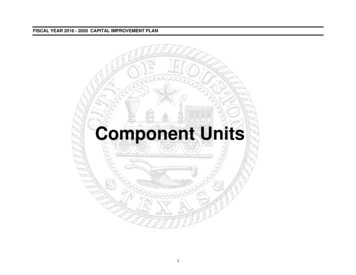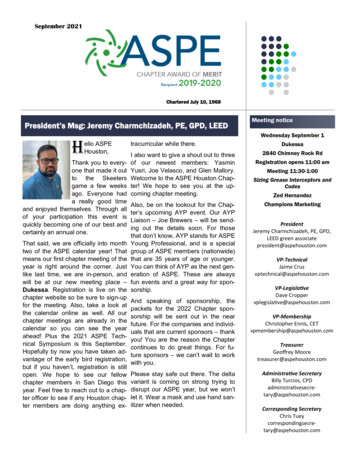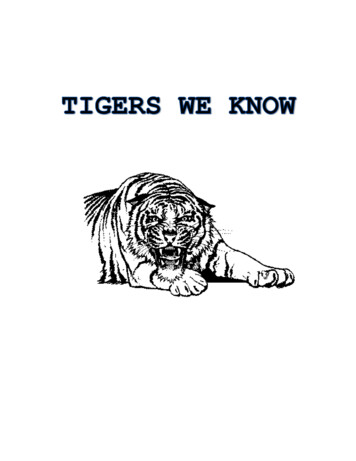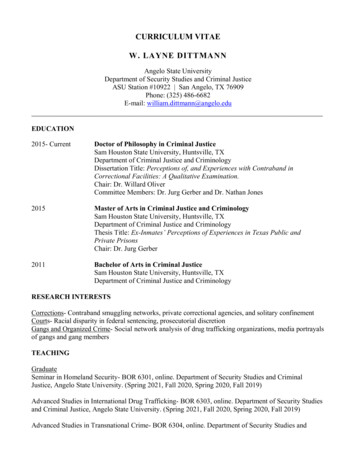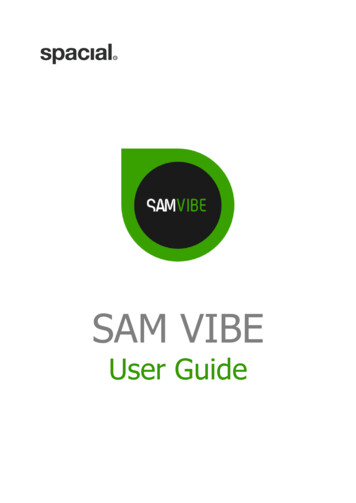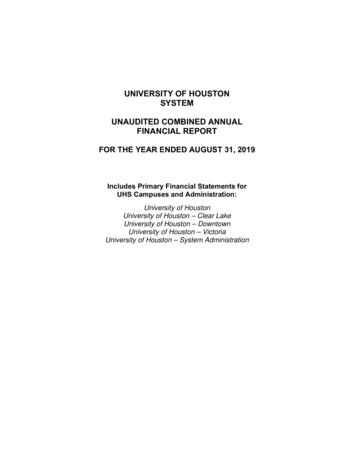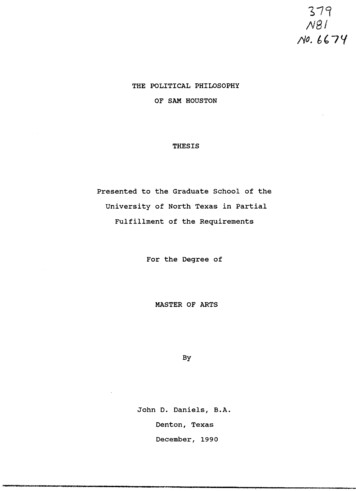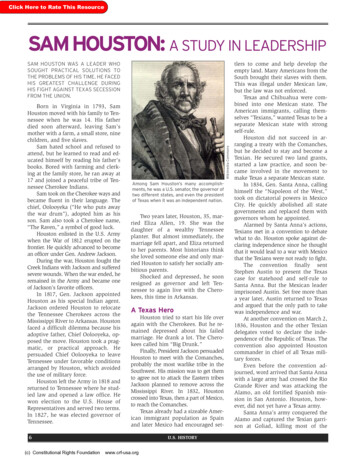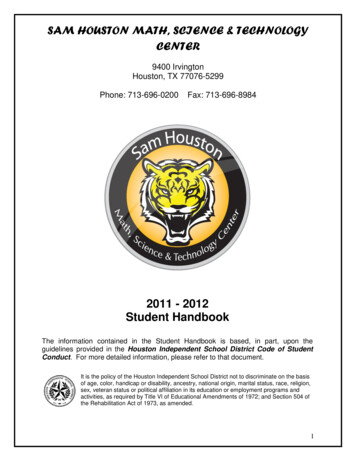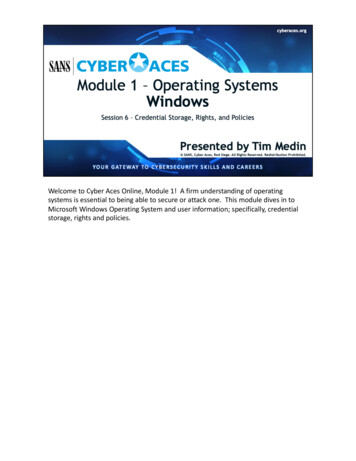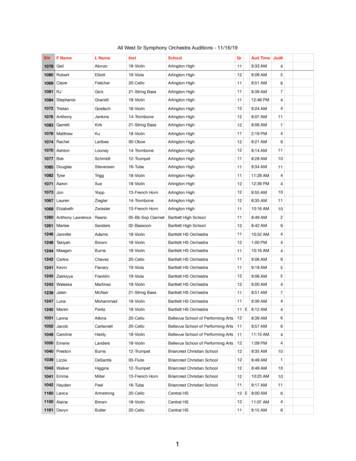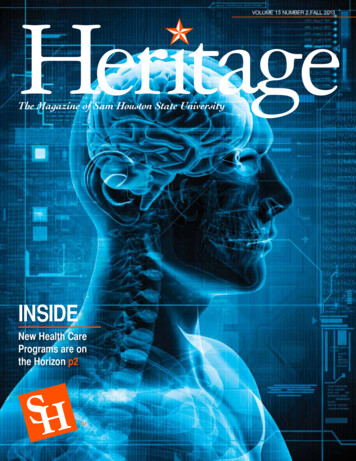
Transcription
VOLUME 13 NUMBER 2 FALL 2013The Magazine of Sam Houston State UniversityINSIDENew Health CarePrograms are onthe Horizon p2
LETTER FROM THE PRESIDENTThe leadership in Texas recognized early on that education was a significant contributingfactor to a healthy economy, thus the founding of Sam Houston as an institution dedicatedto producing highly-skilled teachers. Today, while our academic programming hasexpanded greatly, our focus on educating the Texas workforce has never changed.Sam Houston State continually evaluates opportunities and alliances that will producevalue-added benefits to the university, our students and the community at-large. Fred Pirkle, an SHSU alumnus and founder of Therm-Omega-Tech, generouslypledged the capital needed to build a first-class Engineering Technology programfilling a higher education niche to serve manufacturing and construction needs. The university partnered with the banking industry to develop a unique,recognized academic program that specifically meets the educational skill setrequirements of financial institutions hiring our students, keeping graduates inhigh demand. Collaborating with the Texas Department of Corrections, SHSU built one of thelargest and most diversified criminal justice programs in the world in education,training and research. The PGA Golf Management program, the only one in Texas and one of 19 inthe nation, provides graduates with a business degree education combined withinternships, player development and PGA membership.This focus has clearly paid off—SHSU is ranked 2nd out of 38 public universitiesfor placing 70 percent of our students in the Texas workforce within 12 months ofgraduation. We also received the 2013 designation as a “Low-Cost College with HighStarting Salaries for Graduates” by AffordableCollegesOnline.org.Demographic and regulatory trends have provided the university with new opportunitiesin the area of health care education and, over the past several years, we have beenbuilding the foundation needed to support the creation of a College of Health Sciences.The students graduating from the new college will help fill a critical demand in the healthcare sector and state and local communities, since it is expected that 5.6 million newhealth care jobs will be created, 13 percent of total U.S. jobs by the year 2020. Over 80percent of those 5.6 million jobs will require postsecondary education and training.This is an exciting time for Sam Houston State University as we continue to honor thespirit of our founding by providing the state and nation with graduates who have thenecessary skills to contribute our social and economic well-being. There is no better wayto help shape a brighter future than helping to build the future of our children.Dana GibsonPresident
Spotlight2 ‘Healthy’ PresenceEditorJulia Mayjmay@shsu.eduNew health care programs are on the horizon.WritersJason BarfieldJennifer GaunttJulia MayKim Kyle MorganPaul Ridings5PhotographyBrian BlalockRhonda EllisorDesignJessica Blank6Masthead DesignFord Design281.992.4042Local Nursing FellowshipsStrengthen ProgramA new partnership is benefitting a local hospital and SHSUnursing students.Going Into The ExtremeChemistry professor Thomas Chasteen conducts researchin Antartica.Vice President forUniversity AdvancementFrank R. Holmesholmes@shsu.eduSections10 University FocusAssociate Vice President forMarketing and CommunicationsKristina K. Ruizkruiz@shsu.eduBookshelf, Raven’s Call, Fleming Recieves Award, ShieldsNamed Dean, Spanish Program Reaches Milestone,Scene at SamAssociate Vice President for DevelopmentThelma Mooneymooney@shsu.edu18 Carry The VisionDirector of Marketing and CommunicationsBruce O’Nealboneal@shsu.eduProfessor Honors A Bearkat Family Of Doctors, St. Luke’s AndSHSU Become PartnersDirector of Alumni RelationsCharles Viennealumni@shsu.edu22 Eye On The KatsUnparalled Success, Football Outlook, Sports NotesThe goal of Heritage is to keep you informedabout Sam Houston State University.Heritage is published twice a year by theOffice of University Advancement foralumni, donors and friends of SHSU.To contact the Office of UniversityAdvancement please call 936.294.3625or visit us at shsu.edu/giving.ON THE COVERSam Houston StateUniversity hastaken a giant step inaddressing healthcare demandswith several newprograms.26 Alumni LookSHSU Welcomes 2,000th Life Member, Paving The Way ForFuture Bearkat Doctors, Where Are They Now?, Class Notes,In MemoriumTHE TEXAS STATE UNIVERSITY SYSTEM BOARD OF REGENTSDonna N. WilliamsChairmanArlingtonRon MitchellVice ChairmanHorseshoe BayCharlie AmatoSan AntonioDavid MontagneBeaumontWilliam F. ScottNederlandDr. Jaime R. GarzaSan AntonioVernon Reaser IIIBellaireKevin J. LillyHoustonRossanna SalazarAustinMatthew RussellStudent RegentSan MarcosFA LL 2 0 1 31
Spotlight‘Healthy’ PresenceFactors such as an aging population, new medical technologies, andfederal legislation have increased the need for qualified health careemployees, particularly in areas of allied health. SHSU has taken agiant step in addressing those demands with several new programs.by Julia MaySam Houston State University haslong enjoyed a solid reputation forproducing quality educators andcriminal justice professionals, and in recentyears many other academic programs havebenefited from national attention in waysranging from awards to grants and funding.It may not be much longer before SHSU isrecognized for its health programs.With the creation of the university’snewest academic college, the College ofHealth Sciences, SHSU is moving forwardto establish itself as a provider of qualityhealth professionals in the state, as thedemand for qualified individuals in thefield increases.“It’s a perfect matching of our strengthsat SHSU and the needs of the state ofTexas,” said Jaimie Hebert, provost and vicepresident for academic affairs. “We are inthe right place at the right time.”2 S H S U He r i t a g e M a g a z i n eThose strengths in biology, business,computer science and kinesiology—justto mention a few areas that have impactedthe medical community in recent years—have motivated hospital CEOs andadministrators to ask SHSU to do more toeducate additional nurses and allied healthprofessionals.“This is especially important with federallegislation emphasizing efforts onpreventative care,” Hebert said. “Alliedhealth professionals are going to be theones who really make a difference and getthe job done. Sam Houston State Universityis absolutely tailor-made to fulfill thatmission for Texas and the nation.”About the same time that enrollment atSHSU began to dramatically increaseseveral years ago, university administratorstook note of how state and nationalworkforce trends were shifting toward theneed for more health care professionals.They also noticed that incoming studentswere paying attention to those trends.“We saw the number of pre-professionalstudents increasing dramatically oncampus,” Hebert said. “So we establishedthe Medical and Allied Health ProfessionsOffice, which specializes in advising preprofessional students in the health carefields, provides some auxiliary resources,and assists them with their professionalapplications, among other things. That wasa major step.”The university also received permission tooffer a nursing program, which has seenimmediate success.“It’s small but we are focusing on quality,like we always do at SHSU. We had a 95percent success rate on our first NationalCouncil Licensure Examination, orNCLEX, exams. That’s remarkable,” Hebertsaid.Next, the university brought in MichaelLacourse to be the dean of the new Collegeof Health Sciences. Lacourse came to SHSUfrom the School of Health and HumanFA LL 2 0133
n State UniversngBaches tolosimuHoEventually, some of the programs will beoffered online.yitSaSpotlightnrof sc i ence i nurServices for National University in La Jolla,Calif., where he had served as dean.One of Lacourse’s first moves was to meetwith the deans of the other colleges atSHSU to identify strengths upon whichto build interdisciplinary allied healthprograms.“We created a committee comprised offaculty from all the colleges who hadexperience or degrees or something relatedto health sciences,” Lacourse said. “Thecommittee made a recommendation on thenaming of the college as well as a missionand vision statement.”The founding departments within theCollege of Health Sciences are nursingand health and kinesiology. There areplans to request permission to dividehealth and kinesiology into two separatedepartments—the Department ofKinesiology and the Department of HealthServices and Promotion.“Going forward, we plan to offer ourprograms on two campuses: one here inHuntsville for students who are seekinga traditional college experience and oneat The Woodlands Center so that we canprovide access to our programs to workingadults,” Lacourse said. “In The Woodlandswe’ll have access to great hospitals andresources for students to do their clinicalexperiences and internships.”4 S H S U He r i t a g e M a g a z i n eThe nursing program at SHSU offers ageneric bachelor’s degree, which includesall nursing-related courses that preparestudents to sit for nursing licensure exams.Administrators hope to one day offerthat same program in its entirety at TheWoodlands Center, as well.“In addition to offering the genericbachelor’s degree at The Woodlands Center,we want to offer a degree path to thebachelor’s degree called the RN-to-BSN orADN-to-BSN,” Lacourse said. An ADN issomeone with an associate’s degree whohas passed the licensing exam and is apracticing nurse.“What we are hearing from hospitals is thatthey would prefer to hire bachelor’s-trainedpeople,” he said. “It’s not required, but it’spreferred. So we are going to provide aprogram that will bridge the associate’sdegree to the bachelor’s degree.”At some point, SHSU’s program plans todevelop a degree pathway for students whoare LVNs to earn a bachelor’s degree innursing.“We also want to expand simulationexperiences for our students, because thatis a rapidly developing, evolving area ofnursing education,” he said.“The CEOs of the hospitals that I have metwith have identified a need in the regionfor advanced training in these fields,”Lacourse said. “We will work with them ina collaborative way to make sure that wecan provide the graduates that they need.”“We had an event called the HuntsvilleHealth Science Symposium in thespring,” he said. “We had representativesfrom Huntsville Memorial Hospital, theHealth Services Division of the TexasDepartment of Criminal Justice, and theTexas Department of Health and HumanServices.“It was great,” he said. “It provided awonderful opportunity for people who hadnot met each other to begin to network andbuild relationships.“All of these things we are doing aredirected toward building high-qualityprograms for our students to be successfuland be able to provide services where theyare most needed,” Lacourse said.“We have many priorities, but they arenot mutually exclusive,” he said. “We’llneed highly skilled people to lead our newprograms, as well as new and upgradedfacilities. But we are on track, and we areworking hard to become an acknowledgedleader in educating health scienceprofessionals.”Lacourse is also looking forward toestablishing additional kinesiology andhealth services programs. This summer,the college began developing Bachelor ofScience degrees in public health, healthcare administration, wellness management,and health sciences. Plans for a Bachelor ofScience degree in athletic training are alsoin the works.In thinking of future developments, thecollege conducted feasibility studiesthis summer for offering a doctorate inphysical therapy and a master’s degree inoccupational therapy.Local Nursing Fellowships Strengthen ProgramA partnership between Sam HoustonState University and Huntsville MemorialHospital, which went into effect last fall,will strengthen the nursing programin both organizations and benefit theHuntsville community as well.Five SHSU nursing students were the firstto receive fellowships from HMH to assistwith completing their formal education andprovide additional training in the hospitalunits of their choice.The students held the fellowships for sixmonths, and then became staff nurses atHMH in the unit for which they trained.All of the recipients were in the university’sfirst nursing cohort, and they graduatedtogether from the program in December.It marks the first time the hospital hasentered into such an agreement with anacademic nursing program. The studentswere paid for the training they received,and in return, they committed to two yearsof employment at HMH.They were selected for the fellowshipsthrough a competitive application andinterview process in which representativesfrom the nursing staff at HMH and thenursing department at SHSU participated.“The selected students were given theirchoice of unit, either intensive care,operating room, or labor and delivery,” saidAnne Stiles, chair of SHSU’s Department ofNursing. “The students were precepted andattended special classes at the hospital toprepare them for working in these units.”The students were paid from the hospital’seducation budget rather than each units’budget, because they did not carry a patientload. After they graduated, they advancedto a “graduate nurse” status and received apay raise, while continuing to participate intraining and classes at the hospital.Michael LacourseThe nursing program at HMH is workingtoward The Pathway to Excellence status,The first nursing students to receive fellowships from Huntsville Memorial Hospital are (frontrow, from left): Megan Cress, Molly McMillan and Lauren Mullane, and (back row)Matt Nadzak and Amber Prichard.a designation by the American NursesCredentialing Center, which recognizeshealth care organizations for positivepractice environments where nurses excel.Donna Stewart, Huntsville Memorial’s chiefnursing officer, believes the partnershipbetween HMH and SHSU will strengthenthe ability of the hospital to providesuperior nursing care and help move thehospital’s program toward the prestigiousdesignation.“With these students, we will have nurseswho are newly educated in cutting-edgetechnology, computer savvy, and welltrained to complement our existing,experienced staff,” she said.Stiles believes the partnership has advantagesfor SHSU’s nursing program as well.“Students from the surrounding area aremore likely to be drawn to our program,”she said. “I know a lot of our students arefrom Huntsville, or from this area, andthey want to stay here when they havecompleted their education. This is a perfectprogram for them.”Knowing that they will be able to goimmediately into their specialized area ofinterest is also a tremendous benefit, Stilessaid.“Most new graduates cannot get intospecialized areas in hospitals in largecities right away,” she said. “They workin other, more generalized areas beforebeing allowed to specialize. Here they canimmediately work in the unit they havechosen while being highly supervisedand receiving special training. It’s a superbenefit for our students.”FA LL 2 0135
SpotlightGoingInto TheExtremeChemistry professor Thomas Chasteen has endured arctictemperatures, “foul” penguins and “primordial ooze,” all in thename of research and a cleaner world.by Kim Kyle MorganWild winds, frozen fingers, swayingseas, rudimentary ropes ANDperfidious penguins? ForThomas "Red Head" Chasteen, it wasparadise. In Antarctica. In February.It was a long way from home for Chasteen,a professor in the Department of Chemistryat Sam Houston State University.Dressed like a "Michelin Man" inanticipation of a blizzard, light snowfallinstead greeted Chasteen and a researchteam as they disembarked from an aircraftnear a beach on King George Island. Theyimmediately boarded an inflatable Zodiacboat for a ride across the chilly water to getto a Chilean frigate anchored in the harborat Fildes Bay.6 S H S U He r i t a g e M a g a z i n e"There was no gangplank," Chasteen said."They sent down a rope ladder."Chasteen climbed that rope with packs,gear and equipment on his back, wonderingwhat he'd gotten himself into.Well, extremophiles is what he got into,bacteria that can grow and survive in harshconditions. Antarctica certainly fits the bill.He was there to find the extremophiles.First though, Chasteen was trained bythe Chilean Antarctic Institute to respectthe unusual and pristine conditions ofthe Antarctic. The general rule of thumb,Chasteen said, is "do your science, butchange as little as possible; only disturbwhat you must."It all began 10 years ago, when Chasteenwas collaborating with microbiologists andbiochemists at a few different universitiesin Chile. They were interested in unusualgenetic material inside organisms thatcan do things such as process metals anddetoxify contaminants, Chasteen said.If the unusual genes can be isolated andmoved from one organism to another, andcan then be grown or built up, they can beused for environmental cleanups, Chasteensaid, in a less expensive and less toxic way.bone-rattling cold on Isla Nelson,Antarctica; and getting personal withpenguins in Punta Hannah, Antarctica."In theory, you can design the genesyourself, and that kind of molecular biologyis going on," he said. "But more common,and easier, is to find organisms that haveunusual genes themselves and start movingthem around to other organisms."During the 15-day trip, Chasteen and hismicrobiologist partner, a Chilean doctoralstudent named Juan Pablo Monras (“JP”),gathered approximately 50 water, sedimentand soil samples in sterile containers.That's how Chasteen came to battle windsup to 106 km/hour (about 65 miles perhour) in Punta Arenas, Chile; experiencing"All birds are kind of smelly, but this can'tbe described," Chasteen said. "They poopedsideways—on my boot when I was walkingby. This horizontal ejection techniquecertainly makes them different than otherbirds I've known.""The samples are now at the lab inSantiago, where scientists are enrichingsamples that contain literally millions orbillions of bacteria, and hundreds or tensof thousands of individual species of theindividual bacteria, some of which have thecharacteristics we want and some of whichwe don't," Chasteen said. "After that, theywill begin to manipulate the genes of theorganisms they want and create individualmonocultures of organisms that havethese new, interesting characteristics andabilities."Samples of those will then be sent toChasteen's lab at SHSU for analysis. It'skind of like waiting for Santa in the NorthPole to bring what your heart desires all theway to Huntsville; except you know whenSanta's coming."It could easily be years before we getindividual samples," Chasteen said. "Butthose little, bitty plastic tubes have stuffthat's the culmination of all our work, soit's very exciting."FA LL 2 0137
Spotlightassociate professor of chemistry in 1996and full professor in 2002.While it may be a while before a full loadof samples makes it from the Chilean lab toChasteen's lab, some of his undergrad andgrad students are already preparing.Desire Lopez, a master’s student studyingchemistry, is conducting experimentsto determine how bacteria with unusualgenetics, or bacteria that are geneticallymodified by extremophile genetics, willinteract with toxicants—the things that killthem.When not chasing down what hesometimes referred to as "primordial ooze"in Antarctica, Chasteen enjoys chasing his"academic genealogy" roots, tracing backthe scientists from which he, one way orthe other, sprang. Chasteen has gone asfar back as 1742, Paris, with Pierre JosephMacquer. If it wasn't for the academicgreatness of Macquer, there wouldn't havebeen a scientist by the name of F. WilhelmOstwald in 1878, and so on and so forthdown to John W. Birks at UC Berkeley,who eventually moved to the Universityof Colorado, where he made a lastingimpression on Chasteen.It's too soon to say yet which graduatestudent will follow the academic genealogychart underneath Chasteen, but he hopesit's somebody with a solid sense of humorfor the ickier things in the life, not tomention a way with words.Chasteen's blog of his 15-day Antarcticaexperience is both educational andcomical. He dedicated it to Garry Tisdale,an Antarctic-travelling co-worker of hismother's from Louisiana State Universitywho told Chasteen to go for it eventhough he'd already been dead for some 10years.Read, see photos and watchvideos on Chasteen's blog here:shsu.edu/ chm tgc/Blogs/AB0.html"It's not like he whispered in my ear oranything like that," Chasteen said. "It'sjust that when the possibility came up, Iremembered him telling me once before thatit was something I could one day do, too."And so Chasteen did. In his last blog entry,Chasteen quotes Tom Waits, 1974:"I'm leaving my family,leaving all my friends. Mybody's at home, but myheart's in the wind. Wherethe clouds are like headlines,upon a new front-pagesky. Shiver me timbers, I'ma-sailin' away.""Because these bacteria can survive in suchextreme conditions, maybe they will alsobe more resistant to toxicants than otherbacteria not subject to such conditions,"Lopez said. "This is one question we'llbe answering with the analysis of thisbacteria."Lopez understands this type of researchtakes years, which is why she will continuefollowing Chasteen's progress even aftershe leaves SHSU."I'm very interested in environmental workin general," Lopez said. "Anything that canhelp us learn more about what we can to doprevent further harming the world we livein is worth looking into."Chasteen himself is an environmentalistwho completed his doctorate at theUniversity of Colorado in Boulder in1990. He joined SHSU in 1991, becoming8 S H S U He r i t a g e M a g a z i n eFA LL 2 0139
BookshelfSeventeen faculty publications showcase the workprofessors do outside the classroom.Houston Blue: The Story of theHouston Police DepartmentCriminal justice professor Mitchel Roth and formerHouston Post reporter Tom Kennedy offer the firstcomprehensive history of one of the nation’s largest police forces, the Houston Police Department,reconstructing the history of an agency that has beenboth innovative and controversial. Through extensivearchival research and more than 100 interviewswith prominent Houston police figures, politicians,news reporters, attorneys, and others, the authorschronicle the development of policing in the BayouCity from its days as a grimy trading post in the1830s to its current status.University of North Texas Press—496 pagesstyle and ethics. This textbook, co-authored withEastern Washington University professors MollyKremer Johnson and Teena A.M. Carnegie,introduces professional writing practices to novicewriters using a research-based, problem-solvingapproach to writing, and integrates design andproject management throughout the process.The e-book also includes model documents andexamples of service-learning projects.Kendall-Hunt—286 pagesWho Is Phaedrus?: Keys to Plato’s DyadMasterpieceMarshell Bradley, associate professor of philosophy,comments on the Greek text of Plato’s dialogue“Phaedrus” that ties a unique presentation of thehistorical particulars of the complicated dialogue tothe philosophical topics at issue in the dialogue itself.Pickwick Press—183 pages20132012Geospatial Technologies and AdvancingGeographic Decision Making: Issues andTrendsThe availability of geographically referenced data,the proliferation of geospatial technologies andadvances in spatial analytics have been a boomto applied geographers. Don Albert, professor ofgeography, provides a resource for private and publicsector applied geographers engaged as geospatialtechnicians, analysts, scientists, and managers.Chapters highlight the use of geospatial technologiesto explore applied geographic issues and problems,and studies from economic, urban, population,medical, political and transportation geographies, aswell as the geography of education and geography ofcrime also are considered.IGI Global—423 pages10 S H S U He r i t a g e M a g a z i n eSelling Financial ProductsThe textbook used in finance classes, written by JimBexley, Smith-Hutson Endowed Chair of Banking,is designed to study the process and principlesinvolved in selling financial instruments and services.It emphasizes the special aspects related to selling/marketing in the banking industry. Both financialproducts and services are addressed, and specialattention is given to selling implementation.Pearson Publishing—162 pagesTechnical Communication asProblem SolvingCarroll Ferguson Nardone, associate professorof English, helps students master the art ofcommunicating, broadening their concept of writingby introducing the five foundations of technicalcommunication: problem solving, rhetoric, design,Before the Line, Vol. 3—Caddo Indians: The Final YearsJim Tiller, professor of geography, discusses thelocation of Caddo villages in northeastern Texasduring the Republic period, including the historicvillages of Dehahuit and Timber Hill referenced in the1806 journals of the Freeman-Custis expedition; theremoval of the tribe from their ancestral homeland ineastern Harrison County during the spring of 1838;and the beginnings of the re-assembly processin Indian Territory (1840-1850). This large-formatwork is drawn largely from the archival record andcontains extensive endnotes and more than 40maps, many of them developed by the author.The START Group—202 pagesHard copies and eBook at: m/jim tiller/order/nosoCrime, History, and Hollywood:Learning Criminal Justice HistoryThrough Major Motion PicturesWillard Oliver, professor of criminal justice, andNancy Marion examine 10 films based on actualhistorical cases, from “Amistad” to “All the President’sMen,” analyzing each film’s representation ofthe crimes, the investigation and the courtroomoutcomes. Each chapter introduces a film, followedby the true historical events that the film was basedupon, and a review of the film’s narrative, howHollywood portrayed the historical event, and thefilm’s accuracy. Oliver also extends special thanks tohis students, who gave him the idea for the book.Carolina Academic Press—240 pagesEducation for the Human Brain: A RoadMap to Natural Learning in SchoolsThe all-inclusive book by Timothy B. Jones,associate professor of educational law and policy,presents a natural and brain-compatible instructionalstrategy from early childhood to adult learners.He informs the reader on the science behind thestrategies, motivates the reader with the evidence,and provides a road map for implementation, makingthis book unlike any other available. No matter whatrole or interest a person has in learning, Educationfor the Human Brain can help students within theirreach learn faster and remember more while havingfun learning the way that is natural.R&L Education—190 pagesLangland and the Rokele Family: TheGentry Background to Piers PlowmanRobert Adams, professor of English, supplies hithertoneglected facts about William Langland’s extendedfamily, the Rokeles, and their prominent public roleand its impact on Langland’s writing. The social andpolitical opinions of the Piers Plowman author derivefrom, and reflect, a personal background significantlydifferent from that of Chaucer, Gower, or theanonymous author of Pearl. Langland and the Pearlpoet resemble each other in seeming more politicallyand aesthetically old-fashioned ways than their twogreat London contemporaries. Yet massive evidenceexists of a profound social distance that would haveseparated “William de la Rokele,” at least in his ownmind, from the pious author of Patience, no less thanfrom the city poets.Four Courts—148 pagesPolice Crime Control StrategiesLarry Hoover, director of SHSU’s Police ResearchCenter, compiles existing research on policingapproaches that measurably reduce crime anddisorder and documents the effect of an array ofstrategies, including crime-specific, community- andproblem-oriented, hot spot targeting, concentratedpatrol deployment, disorder interventions andintelligence-guided. Chapters chronologically tracethe accumulating evidence for the substantial impactupon crime that focused police efforts can have,and the role of investigative units in proactive crimereduction is critically assessed. The book concludesby offering a research agenda to improve crimeinterdiction effectiveness.Cengage Learning— 274 pagesPutting Essential Understanding ofFractions into Practice in Grades 3–5Dustin Jones, associate professor of mathematicseducation, along with Kathryn Chval and JohnLannin, from the University of Missouri, focus on thespecialized pedagogical content knowledge neededto effectively teach fractions to third, fourth and fifthgraders. The authors demonstrate how to use thismultifaceted knowledge to address the big ideas andessential understandings that students must developfor success with fractions—not only in their currentwork, but also in higher-level mathematics and amyriad of real-world contexts.National Council of Teachers ofMathematics—148 pagesAn Introduction to theGeography of TourismThe textbook by Velvet Nelson, associate professorof geography, examines tourism as an “astonishingly complex phenomenon that is becoming anever-greater part of life in today’s global world.” Thebook reinforces the relationship between geographyand tourism by using human and physical geography to interpret all facets of tourism—economic,social and environmental—showing how geographyprovides the tools to consider both the positive andnegative factors that affect tourists and destinations,as well as the effects tourism has on both peoplesand places. The introduction enhances students’understanding of geographic concepts and how theycan be used as a way of viewing and understanding the world. Her real-world case studies, basedboth on research and on the experiences of touriststhemselves, vividly illustrate key issues.Rowman & Littlef
alumni@shsu.edu The goal of Heritage is to keep you informed about Sam Houston State University. Heritage is published twice a year by the Office of University Advancement for alumni, donors and friends of SHSU. To contact the Office of University Advancement please call 936.294.3625 or visit us at shsu.edu/giving. SPOT liGHT SECTiONS
